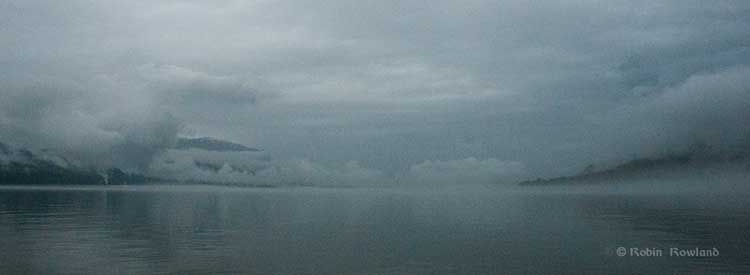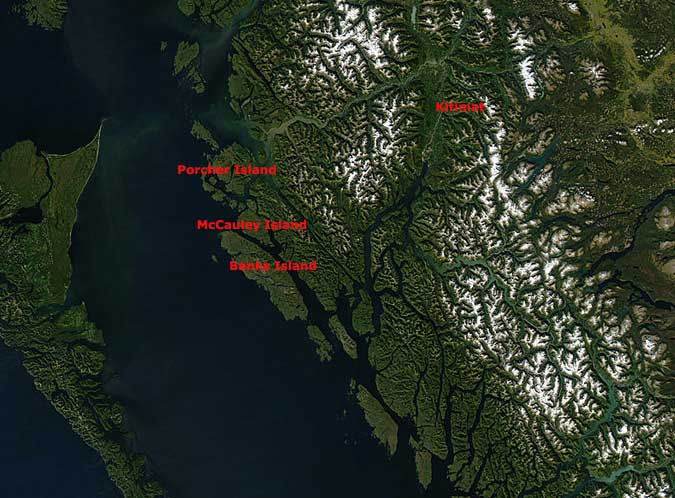Northwest Coast Energy News is republishing this story on spills and other waste from the North Dakota shale oil and gas boom from the U.S. investigative site Pro Publica. Of most interest to readers here in northwest BC is ProPublica’s map of the spills in North Dakota, which is linked to in the story but not part of the republication package. You can find the map at this link or in the body of the story. That spill map, of course, could be a model for anyone tracking similar events in British Columbia.
North Dakota’s Oil Boom Brings Damage Along With Prosperity
by Nicholas Kusnetz, Special to ProPublica June 7, 2012
Oil drilling has sparked a frenzied prosperity in Jeff Keller’s formerly quiet corner of western North Dakota in recent years, bringing an infusion of jobs and reviving moribund local businesses.
But Keller, a natural resource manager for the Army Corps of Engineers, has seen a more ominous effect of the boom, too: Oil companies are spilling and dumping drilling waste onto the region’s land and into its waterways with increasing regularity.
Hydraulic fracturing 2014 the controversial process behind the spread of natural gas drilling 2014 is enabling oil companies to reach previously inaccessible reserves in North Dakota, triggering a turnaround not only in the state’s fortunes, but also in domestic energy production. North Dakota now ranks second behind only Texas in oil output nationwide.
The downside is waste 2014 lots of it. Companies produce millions of gallons of salty, chemical-infused wastewater, known as brine, as part of drilling and fracking each well. Drillers are supposed to inject this material thousands of feet underground into disposal wells, but some of it isn’t making it that far.
According to data obtained by ProPublica, oil companies in North Dakota reported more than 1,000 accidental releases of oil, drilling wastewater or other fluids in 2011, about as many as in the previous two years combined. Many more illicit releases went unreported, state regulators acknowledge, when companies dumped truckloads of toxic fluid along the road or drained waste pits illegally.
State officials say most of the releases are small. But in several cases, spills turned out to be far larger than initially thought, totaling millions of gallons. Releases of brine, which is often laced with carcinogenic chemicals and heavy metals, have wiped out aquatic life in streams and wetlands and sterilized farmland. The effects on land can last for years, or even decades.
Compounding such problems, state regulators have often been unable 2014 or unwilling 2014 to compel energy companies to clean up their mess, our reporting showed.
Under North Dakota regulations, the agencies that oversee drilling and water safety can sanction companies that dump or spill waste, but they seldom do: They have issued fewer than 50 disciplinary actions for all types of drilling violations, including spills, over the past three years.
Keller has filed several complaints with the state during this time span after observing trucks dumping wastewater and spotting evidence of a spill in a field near his home. He was rebuffed or ignored every time, he said.
“There’s no enforcement,” said Keller, 50, an avid outdoorsman who has spent his career managing Lake Sakakawea, a reservoir created by damming the Missouri River. “None.”
State officials say they rely on companies to clean up spills voluntarily, and that in most cases, they do. Mark Bohrer, who oversees spill reports for the Department of Mineral Resources, the agency that regulates drilling, said the number of spills is acceptable given the pace of drilling and that he sees little risk of long-term damage.
Kris Roberts, who responds to spills for the Health Department, which protects state waters, agreed, but acknowledged that the state does not have the manpower to prevent or respond to illegal dumping.
“It’s happening often enough that we see it as a significant problem,” he said. “What’s the solution? Catching them. What’s the problem? Catching them.”
Ron Ness, president of the North Dakota Petroleum Council, a lobbying group, said the industry is doing what it can to minimize spills and their impacts.
“You’re going to have spills when you have more activity,” he said. “I would think North Dakotans would say the industry is doing a good job.”
In response to rising environmental concerns related to drilling waste, North Dakota’s legislature passed a handful of new regulations this year, including a rule that bars storing wastewater in open pits.
Still, advocates for landowners say they have seen little will, at either the state or federal level, to impose limits that could slow the pace of drilling.
The Obama administration is facilitating drilling projects on federal land in western North Dakota by expediting environmental reviews. North Dakota’s Gov. Jack Dalrymple has urged energy companies to see his administration as a “faithful and long-term partner.”
“North Dakota’s political leadership is still in the mold where a lot of our oil and gas policy reflects a strong desire to have another oil boom,” said Mark Trechock, who headed the Dakota Resource Council, a landowner group that has pushed for stronger oversight, until his retirement this year. “Well, we got it now.”
Reaching ‘the Crazy Point’
Keller’s office in Williston is as good a spot as any to see the impacts of the oil boom.
The tiny prefab shack 2014 cluttered with mounted fish, piles of antlers and a wolf pelt Keller bought in Alaska 2014 is wedged between a levee that holds back Missouri River floodwaters and a new oil well, topped by a blazing gas flare. Just beyond the oil well sits an intersection where Keller estimates he saw an accident a week during one stretch last year due to increased traffic from drilling.
Keller describes the changes to his hometown in a voice just short of a yell, as if he’s competing with nearby engine noise. Local grocery stores can barely keep shelves stocked and the town movie theater is so crowded it seats people in the aisle, he said. The cost of housing has skyrocketed, with some apartments fetching rents similar to those in New York City.
“With the way it is now,” Keller said, “you’re getting to the crazy point.”
Oil companies are drilling upwards of 200 wells each month in northwestern North Dakota, an area roughly twice the size of New Jersey.
North Dakota is pumping more than 575,000 barrels of oil a day now, more than double what the state produced two years ago. Expanded drilling in the state has helped overall U.S. oil production grow for the first time in a quarter century, stoking hopes for greater energy independence.
It has also reinvigorated North Dakota’s once-stagnant economy. Unemployment sits at 3 percent. The activity has reversed a population decline that began in the mid-1980s, when the last oil boom went bust.
The growth has come at a cost, however. At a conference on oil field infrastructure in October, one executive noted that McKenzie County, which sits in the heart of the oil patch and had a population of 6,360 people in 2010, required nearly $200 million in road repairs.
The number of spill reports, which generally come from the oil companies themselves, nearly doubled from 2010 to 2011. Energy companies report their spills to the Department of Mineral Resources, which shares them with the Health Department. The two agencies work together to investigate incidents.
In December, a stack of reports a quarter-inch thick piled up on Kris Roberts’ desk. He received 34 new cases in the first week of that month alone.
“Is it a big issue?” he said. “Yes, it is.”
The Health Department has added three staffers to handle the influx and the Department of Mineral Resources is increasing its workforce by 30 percent, but Roberts acknowledges they can’t investigate every report.
Even with the new hires, the Department of Mineral Resources still has fewer field inspectors than agencies in other drilling states. Oklahoma, for example, which has comparable drilling activity, has 58 inspectors to North Dakota’s 19.
Of the 1,073 releases reported last year, about 60 percent involved oil and one-third spread brine. In about two-thirds of the cases, material was not contained to the accident site and leaked into the ground or waterways.
But the official data gives only a partial picture, Roberts said, missing an unknown number of unreported incidents.
“One, five, 10, 100? If it didn’t get reported, how do you count them?” he said.
He said truckers often dump their wastewater rather than wait in line at injection wells. The Department of Mineral Resources asks companies how much brine their wells produce and how much they dispose of as waste, but its inspectors don’t audit those numbers. Short of catching someone in the act, there’s no way to stop illegal dumping.
The state also has no real estimate for how much fluid spills out accidentally from tanks, pipes, trucks and other equipment. Companies are supposed to report spill volumes, but officials acknowledge the numbers are often inexact or flat-out wrong. In 40 cases last year, the company responsible didn’t know how much had spilled so it simply listed the volume of fluid as zero.
In one case last July, workers for Petro Harvester, a small, Texas-based oil company, noticed a swath of dead vegetation in a field near one of the company’s saltwater disposal lines. The company reported the spill the next day, estimating that 12,600 gallons of brine had leaked.
When state and county officials came to assess the damage, however, they found evidence of a much larger accident. The leak, which had gone undetected for days or weeks, had sterilized about 24 acres of land. Officials later estimated the spill to be at least 2 million gallons of brine, Roberts said, which would make it the largest ever in the state.
Yet state records still put the volume at 12,600 gallons and Roberts sees no reason to change it.
“It’s almost like rubbing salt in a raw wound,” Roberts said, criticizing efforts to tabulate a number as “bean counting.” Changing a report would not change reality, nor would it help anyone, he added. “If we try to go back and revisit the past over and over and over again, what’s it going to do? Nothing good.”
In a written statement, Petro Harvester said tests showed the spill had not contaminated groundwater and that it would continue monitoring the site for signs of damage. State records show the company hired a contractor to cover the land with 40 truckloads of a chemical that leaches salt from the soil.
Nearly a year later, however, even weeds won’t grow in the area, said Darwin Peterson, who farms the land. While Petro Harvester has promised to compensate him for lost crops, Peterson said he hasn’t heard from the company in months and he doesn’t expect the land to be usable for years. “It’s pretty devastating,” he said.
Little Enforcement
The Department of Mineral Resources and the Health Department have the authority to sanction companies that spill or dump fluids, but they rarely do.
The Department of Mineral Resources has issued just 45 enforcement actions over the last three years. Spokeswoman Alison Ritter could not say how many of those were for spills or releases, as opposed to other drilling violations, or how many resulted in fines.
The Health Department has taken just one action against an oil company in the past three years, citing Continental Resources for oil and brine spills that turned two streams into temporary toxic dumps. The department initially fined Continental $328,500, plus about $14,000 for agency costs. Ultimately, however, the state settled and Continental paid just $35,000 in fines.
The agency has not yet penalized Petro Harvester for the July spill, thought it has issued a notice of violation and could impose a fine in the future, Roberts said, one of several spill-related enforcement actions the agency is considering.
Derrick Braaten, a Bismarck lawyer whose firm represents dozens of farmers and landowner groups, said his clients often get little support from regulators when oil companies damage their property.
State officials step in in the largest cases, he said, but let smaller ones slide. Landowners can sue, but most prefer to take whatever drillers offer rather than taking their chances in court.
“The oil company will say, that’s worth $400 an acre, so here’s $400 for ruining that acre,” Braaten said.
Daryl Peterson, a client of Braaten’s who is not related to Darwin Peterson, said a series of drilling waste releases stretching back 15 years have rendered several acres unusable of the 2,000 or so he farms. The state has not compelled the companies that caused the damage to repair it, he said. Peterson hasn’t wanted to spend the hundreds of thousands of dollars it would take to haul out the dirt and replace it, so the land lies fallow.
“I pay taxes on that land,” he said.
At least 15 North Dakota residents, frustrated with state officials’ inaction, have taken drilling-related complaints to the U.S. Environmental Protection Agency in the last two years, records show.
Last September, for example, a rancher near Williston told the EPA that Brigham Oil and Gas had plowed through the side of a waste pit, sending fluid into the pond his cattle drink from and a nearby creek. When the rancher called Brigham to complain, he said, an employee told him this was “the way they do business.”
A spokeswoman for Statoil, which acquired Brigham, said the company stores only fresh water in open pits, not wastewater, and that “we can’t remember ever having responded in such a manner” to a report about a spill.
Federal officials can offer little relief.
Congress has largely delegated oversight of oil field spills to the states. EPA spokesman Richard Mylott said the agency investigates complaints about releases on federal lands, but refers complaints involving private property to state regulators.
The EPA handed the complaint about Brigham to an official with North Dakota’s Health Department, who said he had already spoken to the company.
“They said this was an isolated occurrence, this is not how they handle frac water and it would not happen again,” the official wrote to the EPA. “As far as we are concerned, this complaint is closed.”
Salting the Earth
Six years ago, a four-inch saltwater pipeline ruptured just outside Linda Monson’s property line, leaking about a million gallons of salty wastewater.
As it cascaded down a hill and into Charbonneau Creek, which cuts through Monson’s pasture, the spill deposited metals and carcinogenic hydrocarbons in the soil. The toxic brew wiped out the creek’s fish, turtles and other life, reaching 15 miles downstream.
After suing Zenergy Inc., the oil company that owns the line, Monson reached a settlement that restricts what she can say about the incident.
“When this first happened, it pretty much consumed my life,” Monson said. “Now I don’t even want to think about it.”
The company has paid a $70,000 fine and committed to cleaning the site, but the case shows how difficult the cleanup can be. When brine leaks into the ground, the sodium binds to the soil, displacing other minerals and inhibiting plants’ ability to absorb nutrients and water. Short of replacing the soil, the best option is to try to speed the natural flushing of the system, which can take decades.
Zenergy has tried both. According to a Department of Mineral Resources report, the company has spent more than $3 million hauling away dirt and pumping out contaminated groundwater 2014 nearly 31 million gallons as of December 2010, the most recent data available.
But more than a dozen acres of Monson’s pasture remain fenced off and out of use. The cattle no longer drink from the creek, which was their main water source. Zenergy dug a well to replace it.
Shallow groundwater in the area remains thousands of times saltier than it should be and continues to leak into the stream and through the ground, contaminating new areas.
There’s little understanding of what long-term impacts hundreds of such releases could be having on western North Dakota’s land and water, said Micah Reuber.
Until last year, Reuber was the environmental contaminant specialist in North Dakota for the federal Fish and Wildlife Service, which oversees wetlands and waterways.
Reuber quit after growing increasingly frustrated with the inadequate resources devoted to the position. Responding to oil field spills was supposed to be a small part of his job, but it came to consume all of his time.
“It didn’t seem like we were keeping pace with it at all,” he said. “It got to be demoralizing.”
Reuber said no agency, federal or state, has the money or staff to study the effects of drilling waste releases in North Dakota. The closest thing is a small ongoing federal study across the border in Montana, where scientists are investigating how decades of oil production have affected the underground water supply for the city of Poplar.
Joanna Thamke, a groundwater specialist with the U.S. Geological Survey in Montana, started mapping contamination from drilling 20 years ago. She estimated it had spread through about 12 square miles of the aquifer, which is the only source of drinking water in the area. Over the years, brine had leaked through old well bores, buried waste pits and aging tanks and pipes.
In the Poplar study and others, Thamke has found that plumes of contaminated groundwater can take decades to dissipate and sometimes move to new areas.
“What we found is the plumes, after two decades, have not gone away,” she said. “They’ve spread out.”
Poplar’s water supply is currently safe to drink, but the EPA has said it will become too salty as the contamination spreads. In March, the agency ordered three oil companies to treat the water or to find another source.
North Dakota officials are quick to point out that oversight and regulations are stronger today than they were when drilling began in the area in the 1950s. One significant difference is that waste pits, where oil companies store and dispose of the rock and debris produced during drilling, are now lined with plastic to prevent leaching into the ground.
New rules, effective April 1, require drillers in North Dakota to divert liquid waste to tanks instead of pits. Until now, drillers could store the liquid in pits for up to a year before pumping it out in order to bury the solids on site. The rule would prevent a repeat of the spring of 2011, when record snowmelt and flooding caused dozens of pits to overflow their banks.
But Reuber worries that the industry and regulators are repeating past mistakes. Not long before he left the Fish and Wildlife Service, he found a set of old slides showing waste pits and spills from decades ago.
“They looked almost exactly like photos I had taken,” he said. “There’s a spill into a creek bottom in the Badlands and it was sitting there with no one cleaning it up and containing it. And yeah, I got a photo like that, too.”
Keller has grown so dispirited by the changes brought by the boom that he is considering retiring after 30 years with the Army Corps and moving away from Williston. He runs a side business in scrap metal that would supplement his pension.
Still, determined to protect the area, he keeps alerting regulators whenever he spots evidence that oil companies have dumped or spilled waste.
Last July, when he saw signs of a spill near his home, Keller notified the Health Department and sent pictures showing a trail of dead grass to an acquaintance at the EPA regional office in Denver. The brown swath led from a well site into a creek.
If the spills continued, he warned the EPA in an email, they could “kill off the entire watershed.”
EPA officials said they spoke with Keller, but did not follow up on the incident beyond that. The state never responded, Keller said. The site remained untested and was never cleaned up.
“There was no restoration work whatsoever,” Keller said.







